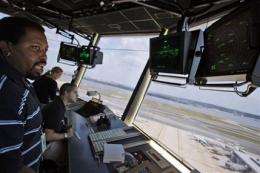Common GPS could help better track airline flights

(AP) -- Get lost in the woods and a cell phone in your pocket can help camping buddies find you. Drive into a ditch and GPS in your car lets emergency crews pinpoint the crash site. But when a transcontinental flight is above the middle of the ocean, no one on the ground can see exactly where it is - in the air, or worse, in the water.
The disappearance of Air France Flight 477 and its 228 passengers over the Atlantic Ocean this week has critics of radar-based air traffic control calling on the U.S. and other countries to hasten the move to GPS-based networks that promise to precisely track all planes. Current radars are obsolete more than 200 miles from land.
"The technology's there - we've had this stuff for 15 years and little's happened," said Michael Boyd, a Colorado-based airline analyst. "My BlackBerry can be used to track me, so why can't we do it with planes?"
U.S. officials have discussed setting up such a network since the 1990s and the technology is being tested in parts of the country, including Alaska and off the Gulf Coast. A few carriers, like Southwest, already use GPS to help planes make quicker landings that burn less fuel.
But full implementation, estimated at a cost of $35 billion, has languished amid funding delays and disputes over technical complexities. Although Transportation Secretary Ray LaHood has said the project will be among the Federal Aviation Administration's top priorities in the Obama administration, the existing radar system is likely to remain for at least another decade.
"It's a crude system they're using now," said Robert Poole, an aviation expert with the free market-oriented Reason Foundation. "For 100 dollars, you can run down and buy a GPS system, put it in your car and know exactly where you are. But planes don't have it."
Some European and Asian countries are moving more quickly toward establishing pricey satellite systems. But many other countries lag behind, including Brazil, where the ill-fated Air France took off Sunday.
Current air traffic systems do not allow controllers to see a transoceanic plane on radar until it is within about 200 miles of land. Instead, controllers often estimate a plane's location based on flight plans and departure times. Such imprecision leaves planes vulnerable in emergencies, such as water landings, Boyd said.
"If a plane ditches and there are survivors, you may not be able to get to it fast enough," he said. "And if an airplane was hijacked in the middle of the Atlantic Ocean, we wouldn't know until it pops up somewhere else."
A reported electrical system failure aboard Flight 477 likely would have knocked out any GPS devices even if the flight had been equipped with that technology. But under a satellite system, rescuers would have known the aircraft's precise location when the failure occurred, presumably making the search area much smaller and helping authorities locate the wreckage faster. That timeliness that can also be crucial in determining a cause of a crash.
Radar quality varies from country to country. For example, many U.S. control centers at least enable planes to send more frequent updates about their location, even when beyond radar's reach.
But over oceans, including vast blind spots in the middle of the Atlantic on U.S.-European routes, pilots usually have to resort to calling controllers with estimated positions every hour or so. The call-ins can frustrate pilots, especially in and around South America, where radio and radar coverage can be patchy, said retired airline pilot Vaughn Cordle, who lives in the Washington area.
"There's nothing worse than going through the painful exercise of trying to talk to someone and letting them know where you are," Cordle said. "The South American region can be more dangerous because pilots are sometimes on their own."
A plane failing to check in after more than two or three hours can be an air traffic controller's worst fear, said New York-based controller Pat McDonough.
"It's very disturbing to the controller to lose an aircraft - you feel responsible," he said. "I sympathize with those guys watching the Air France flight."
GPS proponents say satellite-based air traffic systems provide another benefit that could have directly affected Flight 477, which disappeared into a band of towering thunderstorms. Such systems would collect information from around the globe and allow for real-time weather maps to appear on cockpit displays, giving pilots a tool to better determine how to navigate oncoming weather.
"The point is if we have GPS to monitor airplanes, could it save lives?" Boyd said. "The answer is clearly yes."
©2009 The Associated Press. All rights reserved. This material may not be published, broadcast, rewritten or redistributed.




















